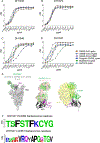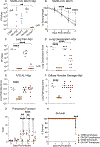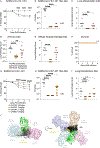A broadly cross-reactive antibody neutralizes and protects against sarbecovirus challenge in mice
- PMID: 34726473
- PMCID: PMC8899823
- DOI: 10.1126/scitranslmed.abj7125
A broadly cross-reactive antibody neutralizes and protects against sarbecovirus challenge in mice
Abstract
Severe acute respiratory syndrome coronaviruses 1 (SARS-CoV) and 2 (SARS-CoV-2), including SARS-CoV-2 variants of concern, can cause deadly infections. The mortality associated with sarbecovirus infection underscores the importance of developing broadly effective countermeasures against them, which could be key in the prevention and mitigation of current and future zoonotic events. Here, we demonstrate the neutralization of SARS-CoV; bat coronaviruses WIV-1 and RsSHC014; and SARS-CoV-2 variants D614G, B.1.1.7, B.1.351, P.1, B.1.429, B.1.526, B.1.617.1, and B.1.617.2 by a receptor binding domain (RBD)–specific human antibody, DH1047. Prophylactic and therapeutic treatment with DH1047 was protective against SARS-CoV, WIV-1, RsSHC014, and SARS-CoV-2 B.1.351 infection in mice. Binding and structural analysis showed high affinity binding of DH1047 to an epitope that is highly conserved among sarbecoviruses. Thus, DH1047 is a broadly protective antibody that can prevent infection and mitigate outbreaks caused by SARS-related strains and SARS-CoV-2 variants. Our results also suggest that the conserved RBD epitope bound by DH1047 is a rational target for a universal sarbecovirus vaccine.
Conflict of interest statement
Figures





References
-
- Li W et al., Bats Are Natural Reservoirs of SARS-Like Coronaviruses. Science 310, 676–679 (2005). - PubMed
Publication types
MeSH terms
Substances
Supplementary concepts
Grants and funding
- F32 AI152296/AI/NIAID NIH HHS/United States
- WT_/Wellcome Trust/United Kingdom
- T32 AI007151/AI/NIAID NIH HHS/United States
- R01 AI157155/AI/NIAID NIH HHS/United States
- U54 CA260543/CA/NCI NIH HHS/United States
- P01 AI158571/AI/NIAID NIH HHS/United States
- U01 AI149644/AI/NIAID NIH HHS/United States
- U19 AI142596/AI/NIAID NIH HHS/United States
- HHMI/Howard Hughes Medical Institute/United States
- UC6 AI058607/AI/NIAID NIH HHS/United States
- P30 CA016086/CA/NCI NIH HHS/United States
- S10 OD018164/OD/NIH HHS/United States
- R01 AI145687/AI/NIAID NIH HHS/United States
LinkOut - more resources
Full Text Sources
Other Literature Sources
Medical
Molecular Biology Databases
Miscellaneous

